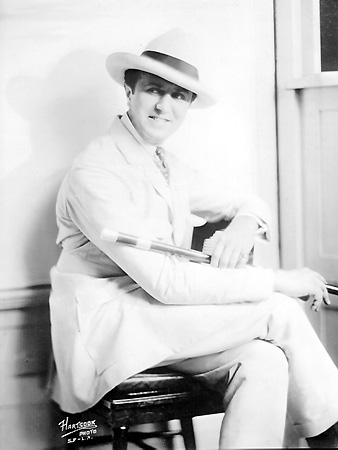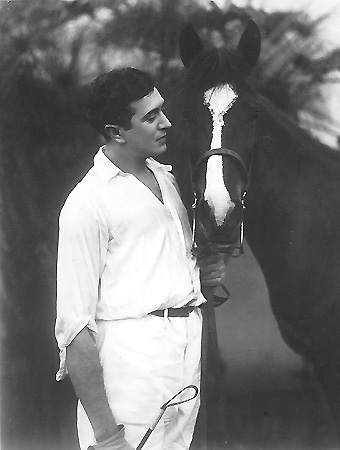 Volume III: Biographies
Volume III: Biographies Volume III: Biographies
Volume III: Biographies


Irving Cummings (L) in a studio portrait taken after the Thanhouser era. Courtesy of the Academy of Motion Picture Arts and Sciences (P-65)
Irving Cummings (R) had a brief stay at the Thanhouser Studio in 1914. Courtesy of the Wisconsin Center for Film and Theatre Research (Q-38)
Thanhouser Career Synopsis: Irving Cummings acted for Thanhouser circa 1910-1911, and again briefly beginning in the spring of 1914. During his 1914 stint he received much publicity. In addition to acting, he wrote at least one scenario, Conscience, which he co-authored with Lloyd F. Lonergan.
Biographical Notes: Born Irving Caminsky on October 9, 1888 (some accounts say October 8), Irving Cummings was educated in New York City. In 1905 he was on the stage with the Broadhurst and Currie stock company in Texas, remaining there for two years, during which time Mary Fuller (who was later to achieve renown in motion pictures) was his leading lady in the well-known melodrama, Way Down East. In the spring and summer of 1911, as well as other times, he was with the Sherman Brown stock company at the Davidson Theatre in Milwaukee, and played leading roles there and elsewhere in a number of successes, including The Man of the Hour, Way Down East, The Great Divide, The Call of the Cricket, In Search of a Sinner (Klaw & Erlanger), and other productions, appearing with Henry Miller, William H. Crane, Lillian Russell (1910-1911, in a juvenile role), and others. His stage career spanned 12 years.
Later in life, Cummings gave many different and quite inaccurate versions of his screen career. In an interview published in the Hollywood Citizen News, April 18, 1945, he said he began in 1910, in California with Jesse Lasky. A few weeks earlier, on February 26th, the same paper said he started in 1909 with Pat Powers in Mount Vernon, New York, in At the Window (which was actually an April 1911 release!). Another account stated that his first film role was in True Indian's Heart, a Bison film released on July 2, 1909.
An article in The Los Angeles Times, June 30, 1939, quoted Cummings as saying that his first screen job was at $30 per week with Francis (sic) Powers, who directed him in The Face at the Window (sic), "made in an old barn in Mount Vernon, New York." The same narrative stated that when he left New York he went to Santa Barbara to work with the American Film Company in The Diamond From the Sky. However, it is probable that Cummings began his screen career circa 1910 with Thanhouser, where he remained for a short time, after which he went to Powers, then to Pathé for one year.
Cummings was with Reliance in 1912 and 1913 and appeared in such films as The Open Road, The Faith Healers, Thanksgiving, Duty and the Man, The Bells, The Man from Outside, London Assurance, and Ashes. His stint with Reliance brought him much publicity. In spring 1913 he was captain of the Reliance studio baseball team. His prowess on the diamond was legendary, and many references to his baseball skill appeared in motion picture trade journals.
The summer of 1913 was one of hardship in his life. Evelyn Francis, his wife of just seven weeks, died in Philadelphia of acute indigestion on July 20th. Miss Francis (her stage name) had been a member of the Orpheum stock company in Philadelphia. In September, Irving Cummings was hospitalized with a bad case of typhoid fever. In September, the trade magazines announced his return to Pathé, beginning October 1st. He started work a week early, his first 1913 Pathé effort being The Finger of Fate. For the next few months he was featured in a number of multiple-reel Eclectic-Pathé films.
On December 13, 1913 The Moving Picture World stated that he had accepted an offer to be a leading man for Universal. A week later, the same publication printed a full-page Universal advertisement announcing Cummings' arrival at its studio. However, the publicity may have been premature, for an article in the December 17, 1913 issue of The New York Dramatic Mirror stated that he had decided to remain with Pathé. Trade announcements early in 1914 stated that he was with Pathé at the time.
The Moving Picture World, March 7, 1914, announced that Cummings had just returned from a week's tour of theatres in the Midwest and had gone back to the Pathé studio. The Motion Picture Story Magazine noted in its March 1914 issue: "Irving Cummings, after changing his label several times, has finally decided to stick to the red rooster" - the latter being the Pathé emblem. For Pathé in 1914 he acted in the five-reel Eclectic feature, The Last Volunteer, for which he stated he was paid $125 per week.
The March 22, 1914 issue of The Morning Telegraph also told of his studio hopping and reported that Irving Cummings had left Pathé to be featured with Thanhouser and had signed a two-year contract, and would begin work as soon as possible. Further: "Mr. Cummings' first appearance was on the so-called legitimate stage, which he deserted to join the Reliance Company. After a long stay with this concern he left to star for Pathé. A short time ago he received an offer from the Universal Film Producing Company and accepted. Later he returned to Pathé, until the offer last week from the Thanhouser Company induced him to leave. He is usually cast for leading roles, although he is particularly fond of playing characters, especially the Italian."
Around the same time, he was in New Orleans with the World Film Producing Corporation working on Uncle Tom's Cabin, according to a notice in the April 15, 1914 issue of The New York Dramatic Mirror. (This film had among its players the erstwhile Thanhouser juvenile actress, Marie Eline.) In March 1914 it was announced that Irving Cummings would start work at Thanhouser's New Rochelle studio "as soon as possible." In its issue of March 18, 1914 The New York Dramatic Mirror informed readers that he had returned to Mutual, "his first love," and that he had "roamed around long enough" and "is now settled for life."
The May 9, 1914 issue of Reel Life stated that: "Irving Cummings entered actively upon his work in the Thanhouser studios two weeks ago. He has been engrossed in a play written especially for him, in which he will soon make his first appearance under the new agreement with his former associates in the Mutual." Soon thereafter Cummings became enamored of Mignon Anderson, the well-known Thanhouser actress, and their engagement was announced in May. Plans did not materialize, and the following year she married another Thanhouser actor, Morris Foster.
In the same year, Irving Cummings appeared in several Thanhouser films, the first being Out of the Shadows, released June 2, 1914. His later Thanhouser films included The Varsity Race and The Diamond of Disaster. Good intentions to the contrary, Cummings soon began to wander again. On October 3, 1914, the New Rochelle Pioneer announced that Cummings had resigned from Thanhouser, and the November 4, 1914 issue of The New York Dramatic Mirror announced that he had joined the B.A. Rolfe Company. In December of the same year he appeared in that company's release of The Three of Us. In the autumn of 1914 he was on stage at the Hyperion Theatre in New Haven, Connecticut, with the Poli Stock Company.
The December 30, 1914 issue of the same publication noted that he had joined the American studios in Santa Barbara, California, a move which had been anticipated by an article in The New Rochelle Pioneer, December 12, 1914: "Rumor has it that Irving Cummings is to link up with the Flying A (American) at Santa Barbara, California, and direct his own company." For American he played the lead in the memorable 1915 serial, The Diamond from the Sky. Soon, the itinerant Cummings was on the trail again, and in December 1915 he signed with the studio of David Horsley, for whom he played the lead in The Explorers.
By 1916 the wandering actor was with Famous Players, where he had roles in The Saleslady, The Feud Girl, The World's Great Snare, and other pictures. His later film releases included The Hidden Scar (Peerless for World, 1916), The Gilded Eye (Peerless for World), The Whip (The Whip Motion Pictures Company for Paragon Films, states rights), A Man's Law (Overland Film, 1917), and The Struggle Everlasting (Harry Rapf, High Art Productions, for Arrow Film). The Moving Picture World, July 14, 1917, announced that the first release of Irving Cummings Pictures, Inc., Man to Man, would be distributed by the Superlative Pictures Corporation. Among Cummings' other pictures were Heart of a Girl (World, 1918), The Debt of Honor (Fox, 1918) The Woman Who Gave (Fox, 1918), The Unveiling Hand (World, 1919), Mandarin's Gold (World, 1919), The Tree of Knowledge (Paramount, 1920), The Ladder of Lies (Paramount, 1920), and Old Dad (Chaplin-Mayer Pictures, 1920).
Irving Cummings was 5'11" tall, weighed 170 pounds (per 1916 and 1918 directory listings), and had black hair and brown eyes. For recreation he enjoyed sports, including swimming, rowing, boxing, baseball, and wrestling. His skill in baseball garnered much admiration from his fellow actors. He married Ruth Sinclair, and by June 1918 was the father of a baby boy, Irving, Jr. Cummings acted in pictures until about 1922, after which he was a director. He directed the first picture featuring the dog Rin Tin Tin and, during a long tenure with 20th Century-Fox, directed numerous Shirley Temple films. In 1943 he was the recipient of the Thomas Edison Foundation Gold Award for outstanding achievement in the arts and sciences.
He retired from films in 1945, having directed, by his own account, 180 pictures. His last film was The Dolly Sisters. He later emerged from retirement to direct a film for his son, Irving, Jr., and to assume the position of host for the Lux Radio Theatre for the Columbia Broadcasting System. Irving Cummings died at the Cedars of Lebanon Hospital, in Los Angeles, California on April 18, 1959, a week after a heart attack. He was survived by his wife of 42 years, Ruth Sinclair Cummings (who was formerly a leading lady on the stage with George M. Cohan), a son, Irving, Jr., and a daughter, Mrs. Jessie Appel.
Note: The New York Dramatic Mirror, in its issue of May 22, 1912, noted that there was another actor named Irving Cummings, who graduated from a theatre school in 1909 and who was sometimes confused with the Irving Cummings described above.
Thanhouser Filmography:
1914: Pamela Congreve (5-26-1914), Out of the Shadows (6-2-1914), The Man Without Fear (6-19-1914), For Her Child (6-23-1914), The Leaven of Good (7-12-1914), The Messenger of Death (7-28-1914), Conscience (8-25-1914), The Varsity Race (9-22-1914), The Diamond of Disaster (10-13-1914)
1914-1915 Serial: The Million Dollar Mystery
1916: Pamela's Past (reissue of the 1914 film, Pamela Congreve, by Exclusive Features 12-1-1916)
1918: The Million Dollar Mystery (edited reissue by Arrow Film Corporation of the 1914 serial; 6-3-1918)
# # #
Copyright © 1995 Q. David Bowers. All Rights Reserved.